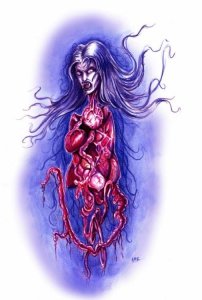We all love Vampires. Don’t deny it. You can whine about Twilight all you like and be justified, but when you get down to it, Vampires are awesome. They’re this sublime amalgam of everything we fear and everything we want to be. Immortal. Undeniable. Tortured. Terrifying. We fear them, we envy them, we, as a culture, are obsessed with them. These creatures have reached out from our eldest irrational fears and legends to be the modern world’s icon. This is a concept who’s fame has reigned unchanged for hundreds of years. Except it hasn’t. Because what we today call a Vampire has next to nothing to do with what our ancestors feared.
Take the thing that was originally called a “Vampire.” This is a creature that was described in Eastern European lore as a man’s corpse, risen to feed on the blood of his family and neighbors. Sound familiar? This next part might not. The Vampire was described as having a bloated body, ruddy skin, and as secreting blood from its mouth and nose. Like, you know, a corpse with an overabundance of blood. And fangless, too. Far cry from the suave aristocratic figure we’ve come to associate with the name.
 I actually couldn’t find an image for the original version. You’ve failed me, Google.
I actually couldn’t find an image for the original version. You’ve failed me, Google.
Our modern Vampire is derived from a sequence of fictional depictions, beginning with John William Polidori, who, as a result the same bout of rainy-day ghost story telling in which Mary Shelley produced Frankenstein, wrote The Vampyre, a short story that told of the original Vampire aristocrat, Lord Ruthven, based on Polidori’s travels as the personal doctor of poet and apparent douchebag Lord Byron.
Polidori’s story would go on to influence James Malcolm Rymer’s novel Varney the Vampire, and the pair of them would influence Joseph Sheridan Le Fanu’s Carmilla, all of which culminated in the most famed of the timeline: Bram Stoker’s Dracula.
Dracula set the standard for Vampire Literature: a dashing romantic nobleman of devious intent, a Vampire with pale skin and fangs.
Other traits would be added on later. For instance the weakness to sunlight was introduced by the film Nosferatu (a total ripoff of Dracula we wouldn’t even know about if a couple copies hadn’t slipped past the widow Stoker’s lawsuit).
But none of that has a thing to do with the original legend.
Call me what you will, (pedantic, obsessive, annoying, I’ve heard them all) but I say we ought to do something about that.
Nearly every culture on the planet has some kind of Vampire. Some demon, or monster, or undead that comes out at night to feed on the blood and flesh of the living. And you know what? Some of them could make old Dracula up there shit his fancy-ass cape.
Take for instance, the Penanggalan. A creature of Southeast Asian folklore, by day it appears as a normal woman. By night, however, it grows fangs, and––wait for it––its head detaches from its body, trailing its luminescent entrails behind it, seeking out the blood of women and young children.

Look at this thing! LOOK AT IT!
That’s only like the third weirdest example I could find! All it takes is a quick stroll through Wikipedia to find an army of things that would make Stoker look like an unimaginative hack.
This is the kind of thing we COULD all be reading about. Instead we get a bunch of basement-dwellers with overbites whining about the human condition. Fuck that, already!
A while ago, I went on a bender through every Wikipedia article on a bloodsucking mythological thing I could find. I cut through all the fiction that other people made up and when straight back to the myth and legend. The result was Live Prey. I created a world where Vampires (not the pale-faced drama queens we’ve all seen a million variants of by now, but the old-fashioned, rotting, creepy, corpse-things lost to fiction) are real, along with Penanggalan, and Strigoi, both Viu and Mort, and Baobhan Sith, and Lilin, and Vetala, and a dozen other things, and they’re all called the Motetz Dam (a hebrew term meaning ‘blood sucker,’ which presumably refers to a specific creature, but that I couldn’t actually find any details on, so I just used it as my overarching term because it sounds cool). And I created a story, both about them, and the people who hunt them. And some other shit that I’ll hopefully get to eventually. And I decided to write it in the form of 30 page, serialized, self-contained stories (much like episodes of a TV show) that I’m letting everybody read for free on a blog, because in case you couldn’t tell by now, I’m really not the sanest guy.
